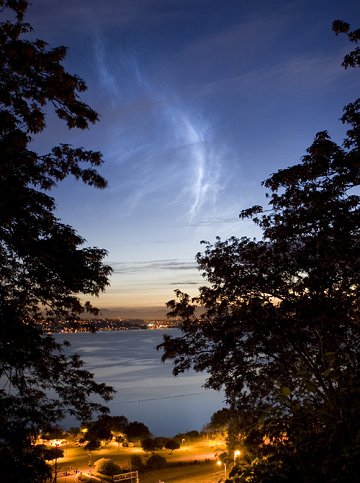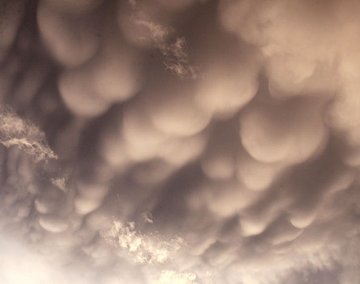 Where's Saturn? Is that a UFO--or the ISS? What's the name of that star? Get the answers from mySKY--a fun new astronomy helper from Meade. Where's Saturn? Is that a UFO--or the ISS? What's the name of that star? Get the answers from mySKY--a fun new astronomy helper from Meade. SOLAR WIND: A solar wind stream is buffeting Earth's magnetic field and causing mild geomagnetic storms. High-latitude sky watchers should be alert for auroras. NLCs INVADE THE USA: On June 19th, bright noctilucent clouds (NLCs) descended over the lower United States. "This is the first time I've seen NLCs in this area for many years," says Kellen Harrel of Portland, Oregon. "The clouds were glowing very brightly." One state away, Jonathan Berry snapped this picture overlooking Lake Washington: 
Photo details: Canon 20D, 24mm, f/2.8, ISO 100, 8 sec
Noctilucent clouds are a mystery. They were first reported in the 19th century after the eruption of supervolcano Krakatoa. In those days the clouds were confined to high latitudes, but they have intensified and spread with sightings in recent years as far south as Colorado and Utah. What causes NLCs? A NASA spacecraft named AIM is orbiting Earth on a mission to find out. Summer is the season for NLCs, so keep an eye on the western sky after sunset. If you see electric-blue tendrils spreading up from the horizon, you've probably spotted a noctilucent cloud. June 2007 Noctilucent Photo Gallery
["Noctilucent Cloud"--the song] [Night-Sky Cameras] MAMMATUS CLOUDS: Two nights ago, Tony Wilder of Chippewa Falls, Wisconsin, went outside to watch a rare double flyby of the space shuttle Atlantis and the ISS. He looked up and saw this: 
Photo details: Canon30D, 1/500s, f16, ISO 100
These are mammatus clouds. They form in turbulent air on the undersides of thunderstorms. Although mammatus clouds are popularly thought to signal the approach of severe weather, new research shows the opposite is true. Mammatus clouds are most often seen when storms are breaking up. Indeed, "the clouds soon parted and I was able to see Atlantis and the ISS playing cat and mouse," says Wilder. "What a night for looking up!" | 
